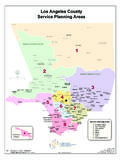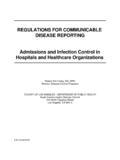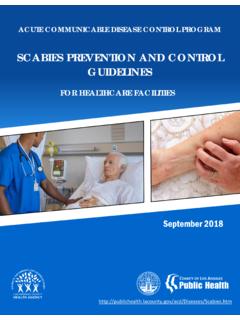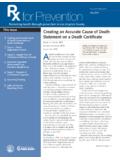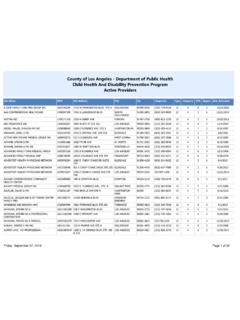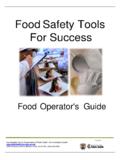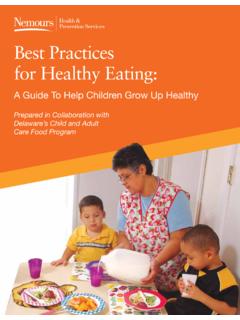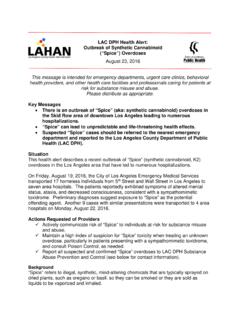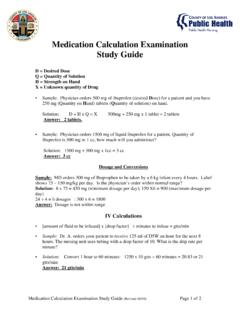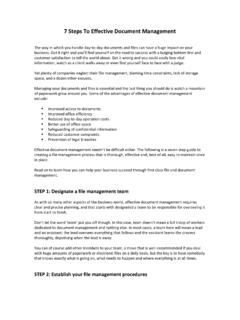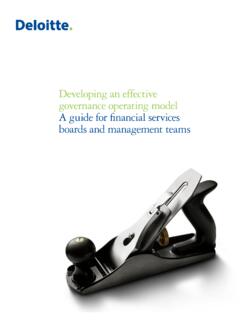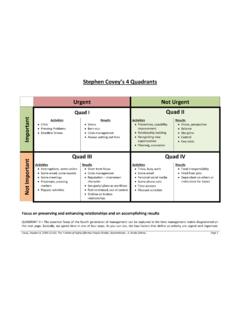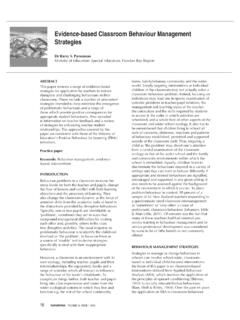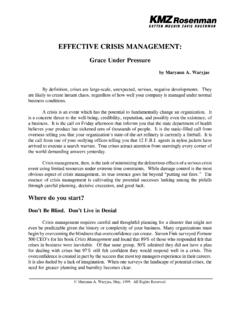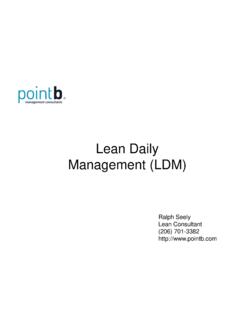Transcription of EFFECTIVE MANAGEMENT OF COCKROACH INFESTATIONS
1 EFFECTIVE MANAGEMENT OF COCKROACH INFESTATIONS County of Los Angeles Department of Public Health Vector MANAGEMENT Program 5050 Commerce Drive Baldwin Park, CA 91706 (626) 430-5450 The four species of cockroaches in Los Angeles County that can become common pests are the German COCKROACH , brown-banded COCKROACH , oriental COCKROACH , and the American COCKROACH . Of these four species, the German COCKROACH has the greatest potential for becoming persistent and troublesome, followed by the brown-banded COCKROACH , both of which prefer indoor locations. Oriental and American cockroaches occasionally pose problems in moist, humid areas. PROBLEMS ASSOCIATED WITH COCKROACHES Cockroaches may become pests in homes, schools, restaurants, hospitals, warehouses, offices, and virtually in any structure that has food preparation or storage areas.
2 They contaminate food and eating utensils, occasionally damage fabric and paper products, leave stains on surfaces, and produce unpleasant odors when present in high enough numbers. When cockroaches that live outdoors come into contact with human excrement in sewers or with pet droppings, they have the potential to transmit bacteria that cause food poisoning (Salmonella spp. and Shigella spp.) if they enter into structures. German cockroaches are believed to be capable of transmitting disease-causing organisms such as Staphylococcus spp., Streptococcus spp., hepatitis virus, and coliform bacteria. They also have been implicated in the spread of typhoid and dysentery. Indoor INFESTATIONS of cockroaches are an important source of allergens and risk for asthma among some populations.
3 The levels of cockroaches and allergens have been directly related to COCKROACH density, housing disrepair, and sanitary conditions. IDENTIFICATION Cockroaches are medium-sized to large insects that have broad, flattened bodies with long antennae and a prominent, shield-shaped section behind the head. Some people confuse them with beetles, but adult cockroaches have membranous wings and lack the thick, hardened forewings of beetles. They are nocturnal and have a tendency to scatter when disturbed. Immature cockroaches, known as nymphs, look like adults, but are smaller and do not have wings. Of the four common pest species, German and brown-banded cockroaches inhabit buildings, whereas the oriental and American cockroaches usually live outdoors or in masonry enclosures away from buildings, only occasionally invading structures.
4 It is important to correctly identify the species involved in a COCKROACH infestation so that the most EFFECTIVE control methods may be chosen. German COCKROACH The German COCKROACH , Blattella germanica, is the most common indoor species, especially in multiple-family dwellings. They prefer food preparation areas, kitchens, and bathrooms because they favor warm, humid areas that are close to food and water. In severe INFESTATIONS they may spread to other parts of the structure. In heavily infested households, the German COCKROACH may be found in every part of the structure and clusters of them may be visible during the day. Generally, for every COCKROACH seen in the daytime there are many more concealed in dark, protected locations. This COCKROACH exhibits grouping behavior, and because they develop from egg to adult by a gradual change in size and form, all developmental stages can be found together in preferred harborages.
5 This species reproduces more rapidly than the other common pest cockroaches. A single female and her offspring can produce over 30,000 individuals in a year when conditions are ideal, but many may succumb to cannibalism and other population pressures. The female is often observed carrying around a light tan egg case (ootheca), about 1/4 inch long, at the tip of her abdomen. She will usually drop it about 2 days before it hatches, but sometimes the egg case hatches while it is still being carried by the female. Each egg case contains about 30 young, and a female may produce a new egg case every few weeks. Recent research suggests the female COCKROACH remains in a secluded harborage and does not venture out for either food or water during the period that she carries the ootheca.
6 This behavior stresses the importance of locating and addressing all harborage sites when attempting to manage an infestation. Brownbanded COCKROACH The brownbanded COCKROACH , Supella longipalpa, is not as common as the German COCKROACH in California and accounts for only about 1% of all indoor INFESTATIONS . This species seeks out areas that are very warm most of the time, preferring temperatures of about 80 F, about 5 to 10 F warmer than what German cockroaches prefer. Favorite locations include near the warm electrical components of appliances such as radios, televisions, and refrigerators. Brownbanded cockroaches prefer starchy food ( , glue on stamps and envelopes), are often found in offices and other places where paper is stored, and are more common in apartments or homes that are not air conditioned or that are kept very warm.
7 They also infest animal-rearing facilities, kitchens, and hospitals. Adult males sometimes fly when disturbed, but females do not fly. Females glue light brown egg cases, which are about 1/4 inch long, to ceilings, beneath furniture, or in closets or other dark places where eggs incubate for several weeks before hatching. Each female and her offspring are capable of producing over 600 cockroaches in one year. Oriental COCKROACH The oriental COCKROACH , Blatta orientalis, is sometimes referred to as a water bug or black beetle. It lives in dark, damp places like indoor and outdoor drains, water control boxes, woodpiles, basements, garages, trash cans, and damp areas under houses when plumbing leaks or landscape watering produce a moisture problem. It is most likely to occur in single-family dwellings that are surrounded by vegetation.
8 It is also common in ivy, ground cover, and outside locations where people feed pets. Oriental roaches prefer cooler temperatures than the other species, and populations of this COCKROACH often build to large numbers in masonry enclosures such as water meter boxes or beneath concrete patio slabs where soil erosion has produced a void. At night, oriental cockroaches may migrate into buildings in search of food and are frequently found in garages. They usually remain on the ground floor of buildings and move more slowly than the other species. Oriental cockroaches do not fly and are unable to climb smooth vertical surfaces; consequently they are commonly found trapped in porcelain sinks or tubs. Females deposit dark red-brown egg cases, which are about 3/8 inch long, in debris or food located in sheltered places.
9 Each female and her offspring can produce nearly 200 cockroaches in one year. American COCKROACH The American COCKROACH , Periplaneta americana, prefers warm and humid environments, usually with temperatures in excess of 82 F. Under the right conditions, they readily live outdoors and are common pests in zoos and animal-rearing facilities. They are also common in underground sewer and steam tunnels, and masonry storm drains. Occasionally they forage from sewers and other areas into the ground floor of buildings. Adult females carry the egg cases around for about 6 days and then cement them to a protected surface where they incubate for about 2 months or longer. The egg cases, which are about 3/8 inch long, are brown when laid but turn black in 1 to 2 days.
10 Each egg capsule contains about 12 young; a female and her offspring can produce over 800 cockroaches in one year. LIFE CYCLE An adult female COCKROACH produces an egg capsule, called an ootheca, which it carries around protruding from the tip of the abdomen. The German COCKROACH carries the ootheca for most of the 30-day incubation period and then drops it about the time the eggs hatch. The other three species carry it for only a short time before depositing it in a suitable location where it incubates for weeks or months. Young or immature cockroaches undergo gradual metamorphosis, which means they resemble adults and have similar feeding habits, but they do not have fully developed wings and are not capable of reproduction until mature. Immediately after molting, cockroaches are white, but their outer covering darkens as it hardens, usually within hours.
